
The lunar South Pole imaged by Kaguya's high-definition camera. The red circle is the Shackleton Crater.
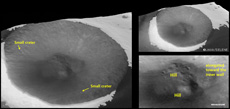
The Shackleton Crater imaged by the Terrain Camera. Exposed relatively-pure water-ice deposits are lacked on the floor at the Terrain Camera's spatial resolution.
The Shackleton Crater, with a diameter of 21 kilometers, is located near the South Pole. Its interior is in permanent shadow - absolutely no sunlight through the year - and extremely cold. Observations by the U.S. lunar explorers Clementine and Lunar Prospector, which were launched in the 1990s, had indicated the possible existence of water ice in the permanent shadow.
Kaguya's Terrain Camera, which has the ability to detect illumination at one ten-thousandth of the intensity of radiation from the sun, imaged the bottom of the Shackleton Crater for the first time. This new data allowed scientists to produce a three-dimensional image of the inside of the crater, with detailed topographic information: 1) the depth of the crater is 4.2 kilometers; 2) the slope angle is 30 degrees; 3) there are a few small craters on the slopes; and 4) on the crater floor, which is 6.6 kilometers in diameter, there are what appear to be landslide deposits from small hills and the crater's surrounding slopes. From the topographic information, scientists determined that the inside of the Shackleton Crater is extremely cold, with a temperature lower than 90K (0K = -273°C,). Water ice evaporates more easily in a vacuum environment than in the atmosphere. But in the 90K environment, it would not evaporate even a few centimeters above the surface, even after billions of years.
In addition, the terrain camera's 10-meter resolution allowed scientists to thoroughly investigate the reflectivity of the crater's bottom. The data confirmed that on the bottom surface, in permanent shadow, there is no visible water ice. If water ice does exist, it is likely to be an extremely small amount, possibly mixed with the soil or hidden in the surface sand (regolith). Indeed, there may be no water ice at all.
The permanent shadow in the Shackleton Crater has long fascinated scientists. Obtaining such detailed data on it is an outstanding achievement by the Kaguya project. This information is expected to contribute greatly to both basic science and future exploration.
Kaguya's Terrain Camera, which has the ability to detect illumination at one ten-thousandth of the intensity of radiation from the sun, imaged the bottom of the Shackleton Crater for the first time. This new data allowed scientists to produce a three-dimensional image of the inside of the crater, with detailed topographic information: 1) the depth of the crater is 4.2 kilometers; 2) the slope angle is 30 degrees; 3) there are a few small craters on the slopes; and 4) on the crater floor, which is 6.6 kilometers in diameter, there are what appear to be landslide deposits from small hills and the crater's surrounding slopes. From the topographic information, scientists determined that the inside of the Shackleton Crater is extremely cold, with a temperature lower than 90K (0K = -273°C,). Water ice evaporates more easily in a vacuum environment than in the atmosphere. But in the 90K environment, it would not evaporate even a few centimeters above the surface, even after billions of years.
In addition, the terrain camera's 10-meter resolution allowed scientists to thoroughly investigate the reflectivity of the crater's bottom. The data confirmed that on the bottom surface, in permanent shadow, there is no visible water ice. If water ice does exist, it is likely to be an extremely small amount, possibly mixed with the soil or hidden in the surface sand (regolith). Indeed, there may be no water ice at all.
The permanent shadow in the Shackleton Crater has long fascinated scientists. Obtaining such detailed data on it is an outstanding achievement by the Kaguya project. This information is expected to contribute greatly to both basic science and future exploration.
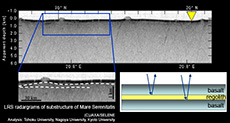
The substructure of a lunar mare comprised of layers of basalt and regolith. The arrows indicate the reflection of radio waves.

Ridges in a lunar mare and a reflection surface in the subsurface. The red arcs indicate the location of ridges. The locations of the deformed parts of the layers and ridges coincide.
To observe the lunar subsurface, KAGUYA's Lunar Radar Sounder (LRS) emits radio waves towards the lunar surface and receives the reflected echo from the surface and subsurface, measuring the time delay. The speed of radio wave echoes depends on the materials they travel through and on the reflectivity of so-called “reflection surfaces” - subsurface planes where layers of different materials meet. LRS investigated the subsurface structure of some lunar maria on the near side, and discovered that they are comprised of layers, as there are reflection surfaces at depths of about 500 meters and 800 meters.
Lunar maria are made from erupted basalt lava. From the surface down to a depth of 500 meters there is a layer of basalt. However, beneath the basalt layer is a layer of regolith (piled sand on the lunar surface), and below the regolith layer is another layer of basalt. In short, the lunar substructure is comprised of layers of basalt, regolith, and basalt stacked on top of each other. This shows that initial basalt flows cooled and hardened, allowing regolith to be deposited on top, and then a greater volume of basalt flow covered the regolith layer.
Furthermore, the layers of basalt and regolith run in parallel, but are both uplifted in the middle, which coincides with topographic ridges on the surface of lunar maria. The fact that the basalt and regolith layers are in parallel shows that the ridge formation occurred after the basalt was deposited on the surface. In other words, scientists speculate that lunar ridges are topographic wrinkles created by diastrophism, which happened when the entire globe contracted as it cooled. Prior to this discovery by KAGUYA, the ridges were believed to have been caused by the weight of the piled basalt layer. The ridge formation occurred less than 2.8 billion years ago, suggesting that the impact of the cooling was rapid and significant.
Lunar maria are made from erupted basalt lava. From the surface down to a depth of 500 meters there is a layer of basalt. However, beneath the basalt layer is a layer of regolith (piled sand on the lunar surface), and below the regolith layer is another layer of basalt. In short, the lunar substructure is comprised of layers of basalt, regolith, and basalt stacked on top of each other. This shows that initial basalt flows cooled and hardened, allowing regolith to be deposited on top, and then a greater volume of basalt flow covered the regolith layer.
Furthermore, the layers of basalt and regolith run in parallel, but are both uplifted in the middle, which coincides with topographic ridges on the surface of lunar maria. The fact that the basalt and regolith layers are in parallel shows that the ridge formation occurred after the basalt was deposited on the surface. In other words, scientists speculate that lunar ridges are topographic wrinkles created by diastrophism, which happened when the entire globe contracted as it cooled. Prior to this discovery by KAGUYA, the ridges were believed to have been caused by the weight of the piled basalt layer. The ridge formation occurred less than 2.8 billion years ago, suggesting that the impact of the cooling was rapid and significant.
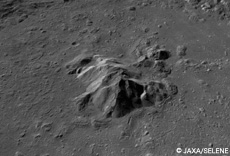
The central peak of the Tycho Crater imaged by the terrain camera. Its peak is 2,480 meters from the crater floor. There is a layer of anorthosite in the subsurface of the central peak.
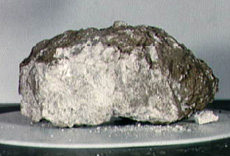
Anorthosite sample returned by Apollo 15 (courtesy: NASA)
KAGUYA's Multi-band Imager (MI) and Spectral Profiler (SP) investigate the distribution of minerals across the Moon by observing the reflected sunlight at the lunar surface. With these instruments, the KAGUYA team studied the mineral composition of a central peak in a crater on the lunar farside. It turned out to be predominantly anorthosite, whose major component is a calcium- and aluminum-rich mineral called plagioclase. Compared to the dark gray color of basalt, the major component of lunar maria, anorthosite is light in color, and is often seen in the lunar highlands. A crater is formed when a small body impacts the surface, but a large impact causes a phenomenon called rebound, pushing subsurface materials up to the surface. Such a site is called a central peak, and by studying such a peak, we can determine the composition of the subsurface layer. The composition of the peak we examined demonstrated that there is a layer of anorthosite in the subsurface, which means that there used to be magma oceans on the Moon.
KAGUYA is the first lunar probe to discover plagioclase with the same spectral profile as the plagioclase sample returned by the Apollo mission. This mineral is the major component of the anorthosite that forms the lunar crust. Other lunar explorers had failed to find the same anorthosite as the Apollo sample - something that puzzled scientists for decades. In addition, the central peak of Tsiolkovsky Crater, located on the farside, had long been believed to be composed of olivine, but KAGUYA has confirmed that it is a mixture of two minerals, pyroxene and plagioclase. Further study is required of other craters that are also assumed to be made of olivine.
As the mineral composition and distribution of the lunar surface is mapped, it becomes possible to identify the temperatures and pressure conditions of magma before it hardened to become mineral. This information can be used to better understand the evolution processes of the Moon, such as how the crust formed from magma oceans that hypothetically existed at the formation of the Moon, and how the erupted lava flows hardened and became lunar maria.
KAGUYA is the first lunar probe to discover plagioclase with the same spectral profile as the plagioclase sample returned by the Apollo mission. This mineral is the major component of the anorthosite that forms the lunar crust. Other lunar explorers had failed to find the same anorthosite as the Apollo sample - something that puzzled scientists for decades. In addition, the central peak of Tsiolkovsky Crater, located on the farside, had long been believed to be composed of olivine, but KAGUYA has confirmed that it is a mixture of two minerals, pyroxene and plagioclase. Further study is required of other craters that are also assumed to be made of olivine.
As the mineral composition and distribution of the lunar surface is mapped, it becomes possible to identify the temperatures and pressure conditions of magma before it hardened to become mineral. This information can be used to better understand the evolution processes of the Moon, such as how the crust formed from magma oceans that hypothetically existed at the formation of the Moon, and how the erupted lava flows hardened and became lunar maria.
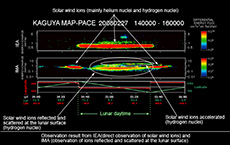
Solar wind ions reflected and scattered at the lunar surface. The yellow circle indicates solar wind ions, and the white circle indicates the reflected and scattered solar wind ions from the lunar surface.
Space is not a true vacuum. In fact, the sun is constantly emitting a great amount of plasma (charged particles), called solar wind, to outer space. The Earth's magnetic fields protect it from direct exposure to solar wind, but the Moon, where there are no large magnetic fields, has no such protection. Scientists had previously thought that solar wind was absorbed when it impacted the lunar surface. However, observation with the Magnetic-field and Plasma experiment (MAP) revealed that: 1) after impacting the lunar surface, 0.1 to 1 percent of solar wind ions lose some energy and are reflected and scattered; 2) solar wind ions normally contain helium nuclei and protons (hydrogen nuclei), but the solar wind ions that are reflected and scattered from the lunar surface contain no helium nuclei and are almost entirely made up of protons; and 3) the reflected solar wind ions from the lunar surface are accelerated.
Regarding lunar magnetic fields, many subtle magnetic anomalies have been confirmed near the South Pole on the farside. KAGUYA is scheduled to descend into a lower orbit to observe the magnetic fields in more detail. Magnetic anomalies on the Moon are thought to have begun three to four billion years ago. By investigating plasma around the Moon and its magnetic fields, KAGUYA aims to explain the evolution of the Moon's magnetic environment.
Regarding lunar magnetic fields, many subtle magnetic anomalies have been confirmed near the South Pole on the farside. KAGUYA is scheduled to descend into a lower orbit to observe the magnetic fields in more detail. Magnetic anomalies on the Moon are thought to have begun three to four billion years ago. By investigating plasma around the Moon and its magnetic fields, KAGUYA aims to explain the evolution of the Moon's magnetic environment.
KAGUYA's Major Scientific Results So Far
KAGUYA: Probing Lunar Science
The First Global Stereo-Imaging of the Moon
Studying the Gravity and Topography of the Moon
A New Era of Lunar Exploration
KAGUYA: Probing Lunar Science
The First Global Stereo-Imaging of the Moon
Studying the Gravity and Topography of the Moon
A New Era of Lunar Exploration